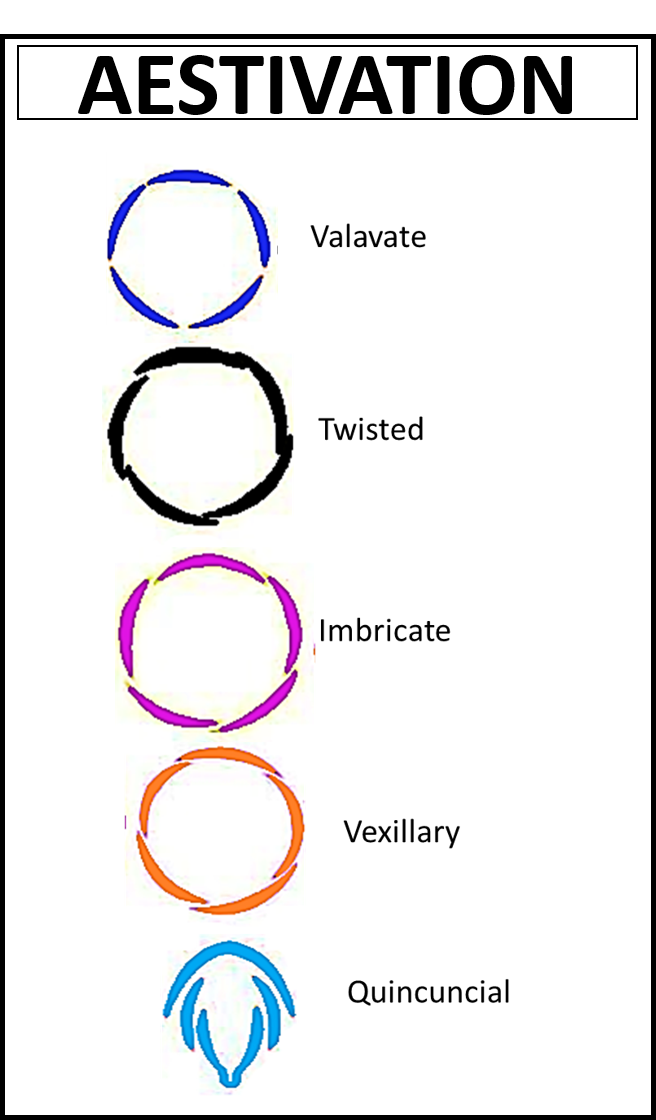
Vexillary aestivation is found in:
(a)Rosacea
(b)Cruciferae
(c)Cucurbitaceae
(d)Papilionaceae
Answer
584.1k+ views
Hint: Aestivation is the mode of arrangement of sepals (calyx) or petals (corolla) in the floral bud with respect to the other members of the same whorl.
Complete answer:
Vexillary aestivation is found in Papilionaceae.
Aestivation is divided into five main types:- Vexillary, Valvate, Twisted, Imbricate, and Quincuncial.
Vexillary Aestivation:- Vexillary aestivation is the arrangement of the corolla in which the anterior petal is the innermost and the posterior petal is the outermost and largest. It is also called as descending imbricate. There is a large petal called 'Standard' which has two lobes fused. The standard petal overlaps two lateral petals called wings which in return overlap the two anterior-most petals called 'keel' or 'carina'. It is the characteristic feature of the papilionaceae family, so also called papilionaceous aestivation.
Additional Information: The other types of aestivation are-
-Valvate Aestivation:- Here the sepals or petals are arranged in a whorl and just touch the margin of one another. For example- Calotropis.
-Twisted Aestivation:- One margin of sepal or petal overlaps to that of the next one. Example- China rose.
-Imbricate Aestivation:- Margin of flower overlaps but not in any particular manner. Example- Gulmohar.
-Quincuncial Aestivation:- When the petals are arranged in a manner that two petals are completely out of the whorl and two are completely inside while one left is half outer and half is on the inner side. Example- Ranunculus.

So, the correct answer is 'Papilionaceae'.
Note: -The order Leguminales consists of three families among which Papilionaceae is the largest family.
-The plants belonging to this family are generally herbs or shrubs (often climbing), very rare trees.
-This family comprises mainly leguminous plants such as alfalfa, clover, beans, peas, chickpeas, lentils, carob, soybeans, peanuts, and tamarind, etc.
Complete answer:
Vexillary aestivation is found in Papilionaceae.
Aestivation is divided into five main types:- Vexillary, Valvate, Twisted, Imbricate, and Quincuncial.
Vexillary Aestivation:- Vexillary aestivation is the arrangement of the corolla in which the anterior petal is the innermost and the posterior petal is the outermost and largest. It is also called as descending imbricate. There is a large petal called 'Standard' which has two lobes fused. The standard petal overlaps two lateral petals called wings which in return overlap the two anterior-most petals called 'keel' or 'carina'. It is the characteristic feature of the papilionaceae family, so also called papilionaceous aestivation.
Additional Information: The other types of aestivation are-
-Valvate Aestivation:- Here the sepals or petals are arranged in a whorl and just touch the margin of one another. For example- Calotropis.
-Twisted Aestivation:- One margin of sepal or petal overlaps to that of the next one. Example- China rose.
-Imbricate Aestivation:- Margin of flower overlaps but not in any particular manner. Example- Gulmohar.
-Quincuncial Aestivation:- When the petals are arranged in a manner that two petals are completely out of the whorl and two are completely inside while one left is half outer and half is on the inner side. Example- Ranunculus.

So, the correct answer is 'Papilionaceae'.
Note: -The order Leguminales consists of three families among which Papilionaceae is the largest family.
-The plants belonging to this family are generally herbs or shrubs (often climbing), very rare trees.
-This family comprises mainly leguminous plants such as alfalfa, clover, beans, peas, chickpeas, lentils, carob, soybeans, peanuts, and tamarind, etc.
Recently Updated Pages
The number of solutions in x in 02pi for which sqrt class 12 maths CBSE

Write any two methods of preparation of phenol Give class 12 chemistry CBSE

Differentiate between action potential and resting class 12 biology CBSE

Two plane mirrors arranged at right angles to each class 12 physics CBSE

Which of the following molecules is are chiral A I class 12 chemistry CBSE

Name different types of neurons and give one function class 12 biology CBSE

Trending doubts
One Metric ton is equal to kg A 10000 B 1000 C 100 class 11 physics CBSE

What is 1s 2s 2p 3s 3p class 11 chemistry CBSE

Discuss the various forms of bacteria class 11 biology CBSE

State the laws of reflection of light

Explain zero factorial class 11 maths CBSE

An example of chemosynthetic bacteria is A E coli B class 11 biology CBSE




